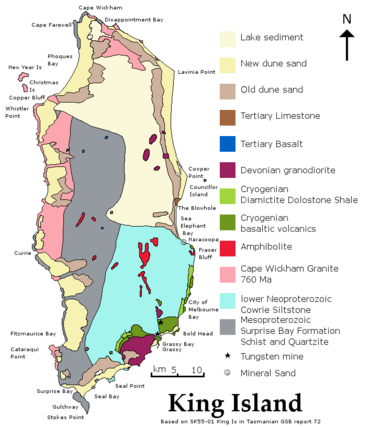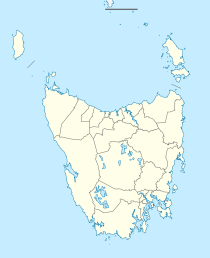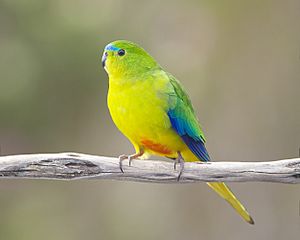Lavinia State Reserve facts for kids
Quick facts for kids Lavinia State ReserveKing Island, Tasmania |
|
|---|---|
|
IUCN Category II (National Park)
|
|

The state reserve occupies much of the north-eastern coast from north of Lavinia Point southwards to Cowper Point and the estuary of the Sea Elephant River.
|
|
| Established | 7 April 1971 |
| Area | 78.81 km2 (30.4 sq mi) |
| Managing authorities | Tasmania Parks and Wildlife Service |
| See also | Protected areas of Tasmania |
|
Designations
|
|
| Official name: Lavinia | |
| Designated: | 16 November 1982 |
|---|---|
| Reference #: | 253 |
Lavinia State Reserve, once known as Lavinia Nature Reserve, is a special protected area. It covers about 78 square kilometers on King Island. This island is located at the western end of Bass Strait, a sea channel between mainland Australia and Tasmania.
Contents
What is Lavinia State Reserve?
This reserve covers a large part of the north-eastern coast of King Island. It stretches from Lake Martha Lavinia in the north down to the Sea Elephant River. Inside the reserve, you can find different types of land. There are swamps, long sandy beaches, and areas with coastal heathland plants. The reserve is very important because it protects the biggest area of natural plants and trees left on King Island.
A Look at the Reserve's History
The idea of protecting this land started in 1959. Back then, a smaller area of 510 hectares (about 1,260 acres) around the Sea Elephant River was officially made a wildlife sanctuary. In 1971, this sanctuary was joined with more land to the north. This larger area was then officially declared the Lavinia Sanctuary.
Later, in 1983, a big area of 1,730 hectares (about 4,275 acres) around the Sea Elephant River estuary was recognized as a wetland of international importance. This happened under the Ramsar Convention. The Ramsar Convention is an international agreement that helps protect important wetlands around the world. This site was only the fifth place in Australia to get this special recognition. In 1994, the boundaries of this Ramsar site were changed to match the current nature reserve.
In 2001, the land that was known as the Lavinia Nature Reserve became the Lavinia State Reserve. This new name made it an even more officially protected area.
The name "Lavinia" comes from an old sailing ship called the Martha Lavinia. This ship was wrecked on a reef near the reserve in 1871. It was carrying potatoes from Tasmania to Adelaide when it sank. Many places along the north-eastern coast of King Island are named after this ship.
Plants and Animals of the Reserve
Flora (Plants)
The reserve is home to three main types of heathland plant communities. These include dry heath with swamp paperbark trees, heath with coastal tea tree, and wet heath with scented paperbark. You can also find the vulnerable scrambling ground fern here. In the past, frequent controlled burning to reduce bushfire risks changed some areas. This caused woody plants to be replaced by bracken ferns and tussock grassland. Near the Sea Elephant estuary, there is also a saltmarsh area.
Fauna (Animals)
Lavinia State Reserve is a vital home for many birds and other animals. One very special resident is the critically endangered orange-bellied parrot. This means there are very few of them left in the world. The reserve also protects a very rare type of brown thornbill that is only found on King Island. Another unique creature found here is the Southern Hairy Red Snail.
Many birds use the reserve for nesting and feeding. Short-tailed shearwaters have their colonies in the sand dunes behind Lavinia Beach. Fairy terns build their nests on the sand spit at the mouth of the Sea Elephant River. On the beaches, you can see hooded plovers and pied oystercatchers nesting. The wet, grassy areas around the estuary are the only known place in Tasmania where the golden-headed cisticola bird lives.



